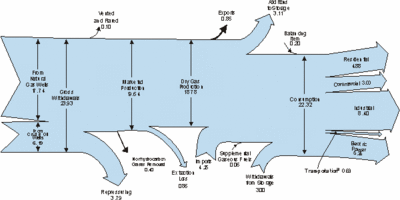Natural Gas
The AER does a great job showing how energy is produced and used with informative flow diagrams. Here is a flow diagram for natural gas. Please note that all figures are in trillions of cubic feet:

For definitions of the processes listed in this diagram, click here. Natural gas is a very versatile fuel, and is consumed in a variety of ways: Residential – 22%, Commercial – 13%, Industrial – 38%, Transportation – 3% and Electric Power – 24%.
Only 15% of natural gas consumed in the U.S. is imported, compared with 65% of oil. 85% of the natural gas imported to the U.S. comes from Canada.
But while natural gas is a versatile fuel, it could also be argued that America has become overreliant on its use.
Since 1992, the electric industry has built over 270,000 megawatts of new natural gas-fired generating capacity. In so doing, we placed unsustainable demands on natural gas supply, and exposed consumers of natural gas, and of electricity from natural gas, to punishing price volatility.
But the problems don't stop there. As NEI's President and CEO, Skip Bowman said in a speech last night in Augusta, Georgia, Hurricane's Katrina and Rita have done vast damage to the nation's natural gas supply and delivery infrastructure:
In the Gulf of Mexico, 50 percent of natural gas production and 60 percent of oil production is still shut down — either because of damage to offshore platforms or to onshore infrastructure. The Gulf of Mexico accounts for approximately one-quarter of U.S. natural gas production and roughly 30 percent of oil production. Most experts believe production will not be fully restored until the end of the first quarter of 2006, at the earliest. There’s little prospect of quick relief from the pressure on natural gas supply and prices.In 2004, natural gas prices were at $5.49 per thousand cubic feet (mcf) at the wellhead. By September 2005, natural gas prices at the Henry Hub were about $12/mcf. Earlier this week, the price reached almost $14/mcf.
Louisiana and Mississippi have suffered greatly, to be sure, but our entire nation will suffer economic damage because of higher energy prices.
In those parts of the country that depend heavily on natural gas for electric power generation — Florida, the West Coast, New England — we can expect significant increases in electricity prices. One Florida electric utility reported last week that its fuel costs have increased by about one-third this year. This, in turn, will increase the cost of electricity to commercial and industrial users by 25 to 40 percent.
Electric utilities in those parts of the country may well find themselves squeezed between rising fuel costs and state regulators trying to protect consumers from the impact of higher prices. Wall Street is already concerned about the potential for stress on utilities’ cash flow, leading to declining credit quality.
Other industries that depend heavily on natural gas, either as a fuel or a feedstock, will suffer, too — chemicals, plastics, packaging, steel, automobile manufacturing. Wall Street is already warning investors away from these sectors. Some were reeling even before Katrina and Rita drove energy prices higher. The U.S. chemical industry has shut down more than a dozen major U.S. manufacturing facilities in the last two years because of high natural gas prices and moved that production overseas. That’s more than 100,000 jobs lost.
Coal
On one of my favorite television shows, The West Wing, Leo McGarry said the U.S. is the Saudi Arabia of coal, and he (or at least the show's writers) couldn't have been more right. Coal is abundant and affordable in the U.S. and the vast majority is used to generate 50% of the nation's electricity.

Since 1975, coal prices have been steadily declining and in 2004 were at $19.85 per short ton.
Together, coal and nuclear energy provide tremendous forward price stability in U.S. electricity markets. Thanks to that forward price stability, retail electricity rates haven't been wracked with the sort of volatility we've seen at the gas pump over the past few months. And without the stability that coal and nuclear provide to retail electricity markets, the impact of the disruption to the nation's natural gas supply caused by Hurricanes Rita and Katrina would be far more dire.
For more information on electricity, stay tuned for the next Stat Pack. For previous Stat Pack’s on the AER click here, here and here.
UPDATE: More from the NAM Blog on natural gas.
Technorati tags: Nuclear Energy, Energy, Economics, Electricity, Natural Gas, Coal, Department of Energy, Hurricane Katrina, Hurricane Rita
0 comments:
Post a Comment